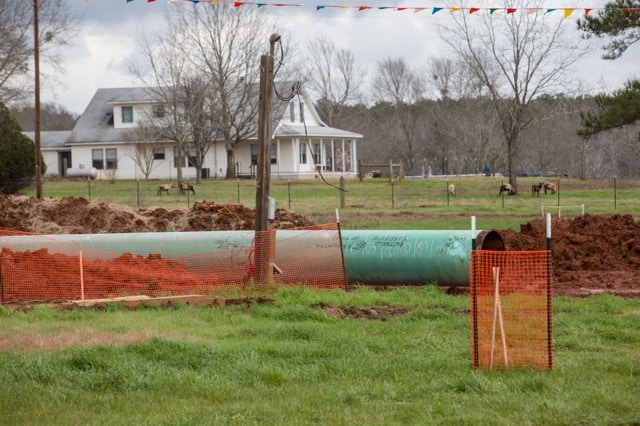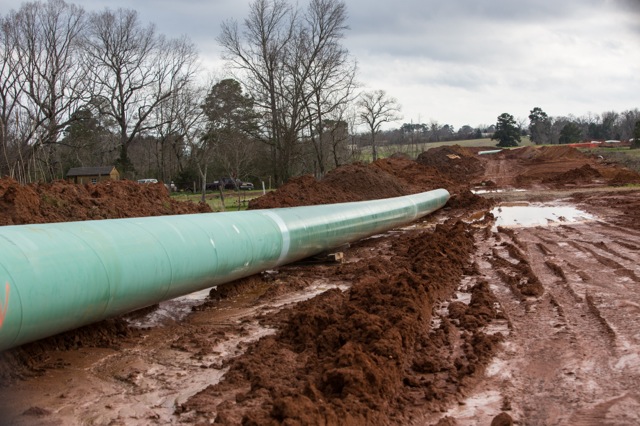Documents obtained by DeSmogBlog reveal an alarming rate of corrosion to parts of TransCanada’s Keystone 1 pipeline. A mandatory inspection test revealed a section of the pipeline’s wall had corroded 95%, leaving it paper-thin in one area (one-third the thickness of a dime) and dangerously thin in three other places, leading TransCanada to immediately shut it down. The cause of the corrosion is being kept from the public by federal regulators and TransCanada.
“It is highly unusual for a pipeline not yet two years old to experience such deep corrosion issues,” Evan Vokes, a former TransCanada pipeline engineer-turned-whistleblower, told DeSmogBlog. “Something very severe happened that the public needs to know about.”
When TransCanada shut the line down, the company and the Pipeline and Hazardous Materials Safety Administration (PHMSA) told the press that the shutdown was due to “possible safety Issues.” And although an engineer from PHMSA was sent to the site where TransCanada was digging up the pipeline in Missouri, no further information has been made available publicly.
Only after DeSmogBlog made a Freedom of Information Act (FOIA) request to PHMSA in August 2013 — which the agency partially responded to this April — was the information revealing the pipeline had deeply corroded in multiple spots exposed. The documents also disclosed a plan to check for a possible spill where the corrosion was detected.
However, documents explaining what caused the corrosion and findings concerning a possible spill were not included in response to DeSmogBlog’s request. According to PHMSA spokesman Damon Hill, documents that might impact an ongoing compliance review the agency is conducting of TransCanada were withheld.
A list of the documents withheld was not provided with the FOIA or a date when the remaining documents would be released.
An email included with the documents suggests Ken Crowl, a representative of TransCanada, sent an email to PHSMA stating the he would provide the agency with “the media talking points” about what the parties had discussed.
When asked why a list of the talking points would not have been included in the FOIA request, PHMSA spokesman Damon Hill told DeSmogBlog such a list might not have been provided, and insisted the agency would have no use for such a list. Yet, TransCanada’s email indicates the two entities compared notes before sharing information with the public.
Richard Kuprewicz, a pipeline safety expert with more than forty years of experience in the energy sector, reviewed the few documents that were obtained. While he found it unusual to see such extensive wall loss in such a short period of time, he was happy to report, “The process worked.”
“TransCanada caught this before it went to failure,” Kuprewicz told DeSmogBlog. “Finding some corrosion issues resulting in anomalies in a pipeline this big is to be expected,” he said. “But the severity of a wall loss of 80% or greater would result in the operator looking for a leak.”
Once a pipeline experiences corrosion “somewhere around 80% — you’re in Never-Never land,” Kuprewicz said. “You have to be real careful, because the engineers will act like the calculations are exact, but when you get to that kind of wall loss it doesn’t take much change in the corrosion rate to take you to failure.”
Kuprewicz wouldn’t speculate on the cause of the corrosion because he didn’t have the documents he would need to make such a determination. The missing documents also made it impossible for him to ascertain if a spill took place before the line was shut down, but he said it would not surprise him if a small spill had occurred.
However, the only PHMSA-generated document included in the FOIA response, an internal email sent by PHMSA representative David Barrett, confirms the possibility of a spill.
Though Kuprewicz commends TransCanada for taking the appropriate steps after finding the initial problem, the question remains why the company didn’t catch the problem before there was 95% wall thickness loss.
Vokes, who also reviewed the documents, isn’t surprised the pipeline had major issues. To him, it was a predictable outcome. Not only has he witnessed TransCanada’s risky behavior first-hand during his five years on the job, Canada’s National Energy Board had found TransCanada guilty of non-compliance prior to his working for the company.
An advocate for pipelines, Vokes had hoped to help TransCanada clean up its act. He believes pipelines are the best way to transport crude oil and tar sands product, as long at operators comply with the rules.
But if the rules aren’t followed, all bets are off. Better a train carrying petroleum products fail than a shoddily built pipeline, because a train accident would have a limited scope, while a pipeline failure could cause damage on a catastrophic scale. (Caveat, of course, would be a “bomb train” oil-by-rail incident in a population center.)
An analysis of what caused such deep corrosion in Keystone 1 in a short period of time would show that “a bunch of professional engineers were behaving badly,” Vokes said, “because there are adequate checks and balances in the regulations to avoid this.”
According to Vokes, “The direct effect on shareholders of the estimated revenue loss for the shut down lasting four and a half days is 20 million dollars.” He believes that the shareholders, himself included, are entitled to know what caused the shutdown.
TransCanada’s non-compliance with regulations is nothing new. Vokes shed light on the company’s risky behavior in 2011 by turning over internal documents to the Canadian National Energy Board and PHSMA. Later, he gave the same documents to the Canadian Senate, resulting in a probe of the company’s compliance practices.
According to a recent report by Reuters, Canadian regulators began investigating TransCanada’s safety practices again, after it received documents submitted by another whistleblower.
The final inspection report of the Keystone XL southern route (now known as the Gulf Coast pipeline) was also obtained by DeSmogBlog. It offers further evidence that TransCanada is not code complaint. The report concluded TransCanada’s work to be unsatisfactory in more then seven areas it considered.
Furthermore, last year, when the Keystone XL‘s southern line was shut down shortly after it was put into operation, many questioned TransCanada’s claim that it was due to planned routine work, since shutting down a pipeline costs a company millions of dollars.
PHSMA confirmed it looked into the shutdown. However the agency “did not dispatch an inspector since the shutdown was not reported to have involved any safety issues,” Hill wrote in an email to DeSmogBlog.
Meanwhile, TransCanada is seeking a recertification of the Keystone XL pipeline permit from the South Dakota Public Utilities Commission. The permit expired last year.
The grassroots citizens group Dakota Rural Action has retained lawyers Robin Martinez and Bruce Ellison to challenge recertification.” The Dakota Rural Action group plans to challenge TransCanada on its inability and/or unwillingness to put safety first in its construction and operations,” Ellison wrote to DeSmogBlog. The lawyers believe they have enough documentation to show the company’s pipeline should not be recertified.
The hearing, scheduled to take place on May 5, was postponed until sometime this summer after pressure was put on the Public Utility Commission to give those testifying against TransCanada more time. Many of those opposed to the pipeline made allegations that they were given insufficient time to complete discovery before the hearing.
Vokes, who will be testifying as an expert witness for the Dakota Rural Action group, recently reviewed pre-hearing testimony that TransCanada’s expert witnesses submitted to the Public Utilities Commission. The company’s experts failed to disclose the corrosion incident in the Keystone 1 line, and the fact that the company is under a compliance review by U.S. regulators.
The Association of Professional Engineers, Geologists and Geophysicist of Alberta’s guidelines for giving testimony make disclosing such information mandatory, according to Vokes.
The results of PHMSA compliance review of TransCanada could impact the permit hearing in South Dakota, as well as on the permit the company needs approved by President Obama to complete the northern route of the Keystone XL pipeline.
When President Obama vetoed the Senate bill that would have enabled TransCanada to finish building the Keystone XL, he didn’t rule out the possibility he might grant the permit once the State Department’s review of the pipeline is complete. The fate of the Keystone XL completion is still in the president’s hands.
If PHMSA has evidence TransCanada is not adhering to the rules, we can only hope the agency will release that information before decisions regarding additional pipelines TransCanada seeks permission to build are made.
Image credit: 2/18/2013 Southern route of the Keystone XL pipeline being installed in Douglas,Texas ©2013 Julie Dermansky
Ed. note 5/1/15: DeSmogBlog has repeatedly asked Davis Sheremata, a TransCanada spokesman, if the Keystone 1 pipeline had issues with the cathodic protection. On May 30, 2014, Sheremata wrote in an email to DeSmog, ” I don’t think we have had issues but will get back to you on Monday. “ However he never did. DeSmogBlog reached out to him again before publication of this report asking the question, but again did not hear back.
Blog Image credit: 2/18/2013 Southern route of the Keystone XL pipeline being installed in Douglas, Texas ©2013 Julie Dermansky
Subscribe to our newsletter
Stay up to date with DeSmog news and alerts







